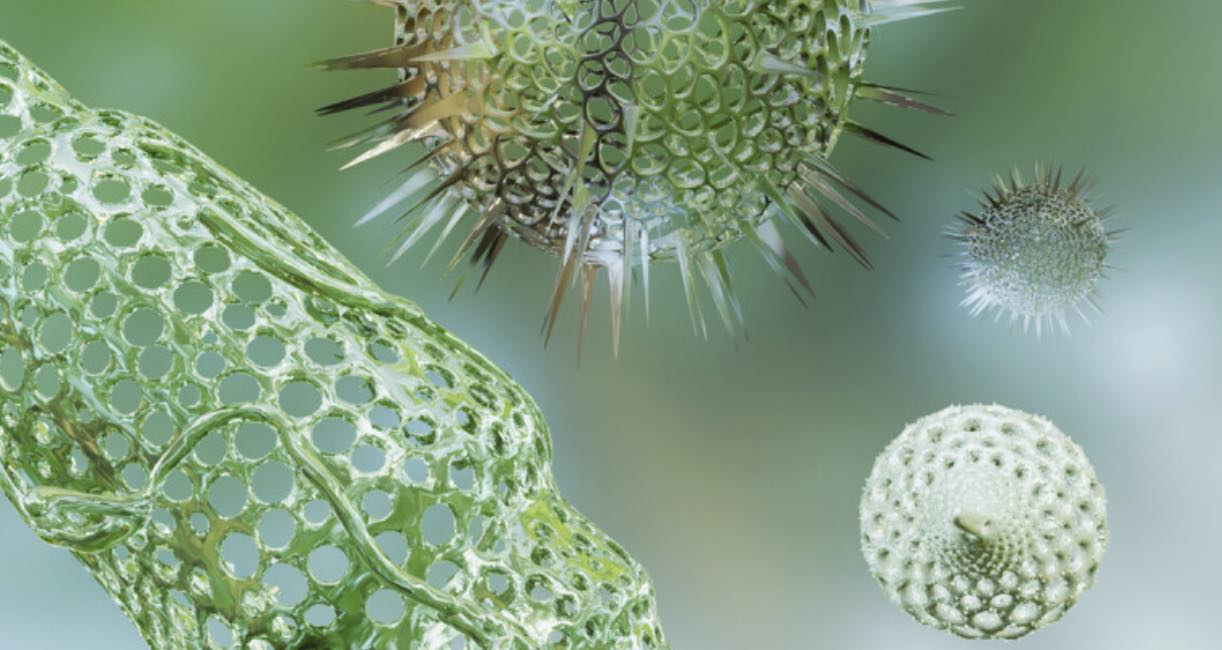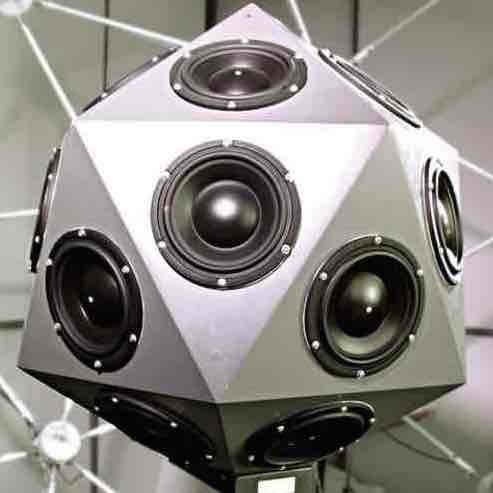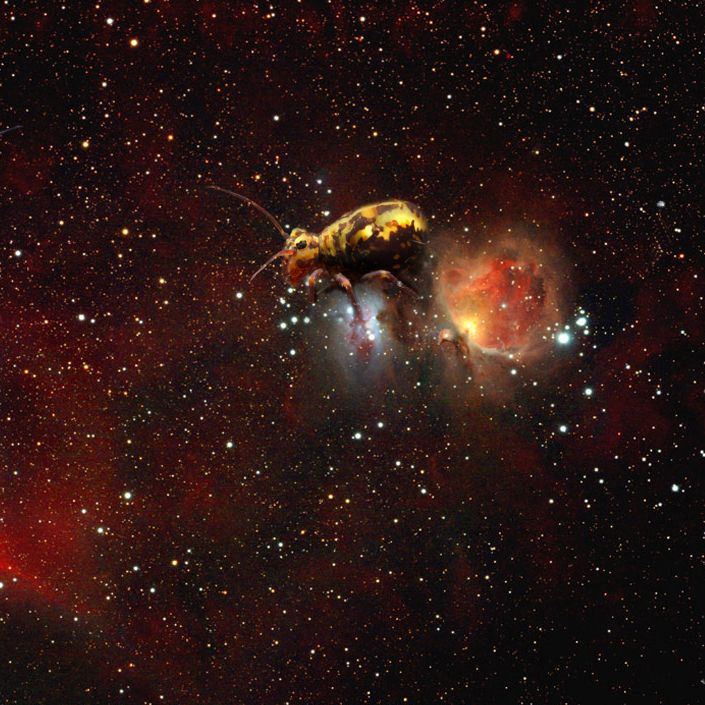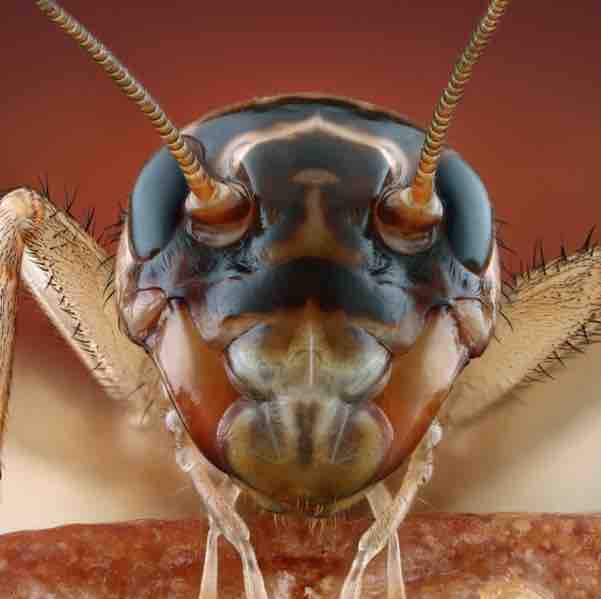Ana Dall’Ara‑Majek
sound artist | composer
Acousmatic works

|
Mare Buchlaestereo, 11:53, 2023 - Listen to the music (mp3) |
Mare Buchlae – Radiolaria’s overture – takes us from the human world to the world of underwater organisms. The piece features all the sound families that represent the plankton-inhabiting species that will be explored individually later on in the cycle. My objective was to recreate an underwater world using only sound synthesis, moving from ocean field recordings to a waterscape consisting entirely of Buchla 200 sounds.
[FR] Entrée en matière du cycle Radiolaria, Mare Buchlae propose une plongée où nous passons du monde des humains à celui des organismes sous-marins. La pièce est une exposition qui fait entendre toutes les familles de sons représentant les espèces peuplant le plancton, et qui seront explorées tout au long du cycle. Le défi était de recréer un environnement sous-marin uniquement avec des sons de synthèse, en passant progressivement de prises de son de l’océan vers un paysage entièrement composé avec les sons du synthétiseur Buchla 200.

|
Perpetuum Spiraestereo, 5:34, 2023 - Listen to the music (mp3) |
[EN] Perpetuum Spirae features radiolarians, unicellular micro-organisms that produce symmetrical and spherical silica skeletons, the variety and complexity of which is quite impressive. Think of underwater snowflakes. In the 19th century, the naturalist Ernst Haeckel identified hundreds of shapes. Among the most fascinating ones are skeletons that encapsulate a miniature version of themselves, like possibly infinite Russian dolls. This fractal shape gave me the idea of a work made by overlaying one sound with larger and smaller versions of itself.
I chose a sequence made on the Buchla 200 synthesizer as a starting point. I transposed that sequence several times and in extreme ways, then overlaid all these instances. Totally unexpected sounds emerged from the process, allowing me to create a plethora of variations for every dimension. I looked for mineral sounds to translate the idea of shells clinking one against another, like radiolarians’ silica skeletons. The ocean can be heard in the background as waves that occasionally “overturn” the properties of the environment, shedding new light on the underwater landscape.
[FR] Perpetuum Spirae met à l’honneur les radiolaires, des micro-organismes unicellulaires qui ont la particularité de former des squelettes en silice symétriques et sphériques, d’une diversité et d’une complexité impressionnante, faisant penser à des flocons de neige sous-marins. Au 19e siècle, le naturaliste Ernst Haeckel a répertorié des centaines de formes, et parmi les plus fascinantes, on trouve celles dont le squelette a encapsulé une version miniature de lui-même dans un jeu de poupées russes qui pourrait potentiellement être infini. Cette forme fractale m’a donné l’idée d’une composition construite à partir de la superposition d’un son avec des versions plus grandes et plus petites de lui-même.
J’ai pris comme point de départ une séquence réalisée sur le synthétiseur Buchla 200 que j’ai transposée de nombreuses fois, et de manière extrême, avant de superposer toutes les instances. Ce processus a fait apparaître des sons complètement inattendus qui m’ont permis de créer une multitude de variations pour chaque dimension. J’ai cherché des sonorités minérales pour mettre en évidence l’idée de coquilles qui s’entrechoquent à l’image des squelettes en silice des radiolaires. En toile de fond, l’océan est présent, il forme des vagues qui parfois «renversent» les propriétés de l’environnement pour donner de nouveaux éclairages au paysage sous-marin.

|
Parasiti Fluxiquestereo, 5:47, 2023 - Listen to the music (mp3) |
[EN] In several underwater animal species, the juveniles are very tiny and live as part of the plankton until they reach their adult age. For Parasiti fluxique, I wanted to create an imaginary environment that would make the voice of micro-plankton audible. I imagine it as tiny isolated points, fragile parasites adrift in the vastness of the ocean. I explored a gamut of micro-sounds, impulses and “slimy” sonorities, through modular synthesis, to make these tiny larval beings heard. I am trying to gradually make these frail micro-sounds “grow” into denser, stronger sounds, like juveniles reaching their adult size. Meanwhile, human activities are detectable, including industrial fisheries, which makes it hard for adult species to survive. In my soundscape, some individuals manage to slip through the net and go on perpetuating their species.
[FR] Dans le monde sous-marin, les juvéniles de nombreuses espèces animales ont une taille minuscule et font partie du plancton avant d’atteindre l’âge adulte. Dans Parasiti fluxique, j’ai voulu créer un environnement imaginaire où l’auditeur pourrait entendre la voix du micro-plancton. Je l’imagine comme des petits points isolés, de frêles parasites qui errent dans l’immensité de l’eau. C’était l’occasion d’explorer toute une gamme de micro-sons, d’impulsions, et de sonorités «visqueuses» par la synthèse modulaire pour illustrer ces petits êtres à l’état larvaire. Progressivement, j’essaie de faire «grandir» ces fragiles micro-sons vers des sonorités plus denses et robustes pour montrer que les juvéniles atteignent une taille plus adulte. Pendant ce temps, les activités humaines sont perceptibles, notamment la pêche industrielle qui rend la survie des espèces adultes très ardue. Dans mon paysage sonore, quelques individus réussissent à passer entre les mailles du filet et à recommencer le cycle de perpétuation de l’espèce.

|
Canticum Asphodelistereo, 11:13, 2023 - Listen to the music (mp3) |
[EN] This work brings to mind diatoms, a remarkable member of the phytoplankton. Diatoms are microscopic algae. There are so many of them that they colour the ocean and become visible from space. I imagined the point of view of someone posted in a space station observing Earth and the blooms of diatoms that seem to be stationary, like large blots of light-hued paint in the deep blue of the ocean.
To illustrate this idea, I composed a contemplative piece of music made of a long, continuous swaths of sound. It consists of pure waves and unfolds with potentially infinite duration. Less pure elements are added for contrast. I wanted to create a shadowy world where nothing is clearly detectable. The title is a reference to the Asphodel Meadows, a section of the Greek underworld, which I understand as a vast plain where nothing is happening, nothing is standing out, everything is underlying.
[FR] Cette pièce évoque les diatomées, membre remarquable du phytoplancton. Ces micro-algues sont si nombreuses qu’elles colorent l’océan et deviennent visibles depuis l’espace. J’ai ainsi imaginé le point de vue d’une personne postée dans une station spatiale, observant la Terre et les efflorescences de diatomées qui semblent immobiles, comme de grandes taches de peinture claires dans le bleu profond de l’océan.
Pour illustrer cette idée, j’ai composé une musique contemplative avec une seule et longue tenue. Formée d’ondes pures, elle se déploie dans une durée potentiellement infinie, à laquelle s’ajoutent des éléments plus impurs qui viennent la colorer. J’ai cherché à créer une atmosphère en demi-teinte où rien ne se distingue réellement. Le titre fait d’ailleurs référence au pré de l’Asphodèle, l’un des enfers grecs, qui m’évoque une vaste plaine où rien ne se passe, rien n’est saillant et tout est sous-jacent.

|
Ostinato Micromacrostereo, 13:56, 2023 - Listen to the music (mp3) |
[EN] Ostinato Micromacro, the last piece in the Radiolaria cycle, evokes the evolution of plankton on a planetary scale, i.e. over billions of years. Planktonic organisms have survived from the early times of the appearance of life on Earth, when volcano lava was still generously flowing, up to the Anthropocene, fine-tuning their morphologies and modes of existence to reach the forms we see today.
To illustrate this idea, I composed simple, stripped-down minimalist music that unfolds slowly. The ostinato represents time ticking away inexorably, and the electronic sounds with irregular rhythms are the plankton dancing with the currents. The nature of these sounds is evolving little by little as eras pass by. I wanted to tell the tale of microscopic evolutions over macroscopic times.
[FR] Dernière pièce du cycle Radiolaria, Ostinato micromacro évoque l’évolution du plancton à l’échelle planétaire, c’est-à-dire dans une temporalité qui s’étend sur des milliards d’années. Des premiers âges de l’apparition de la vie sur la Terre, où la lave des volcans coule encore abondamment, jusqu’à l’anthropocène, les organismes planctoniques ont survécu, ils ont raffiné leurs morphologies et leurs modes d’existence atteignant les formes que nous leur connaissons aujourd’hui.
Pour illustrer cette idée, j’ai composé une musique minimaliste, simple et épurée, qui progresse très lentement. L’ostinato représente le temps qui passe inexorablement, et les sons électroniques à la rythmique irrégulière représentent le plancton qui danse au rythme des flots. Petit à petit, la nature de ces sons évolue pendant que les ères s’enchaînent. J’ai souhaité raconter l’histoire d’évolutions microscopiques qui se déroulent dans un temps macroscopique.
 |
Improvisus B200-1stereo, 7:24, 2022 - Listen to the music (mp3) Improvisus B200-2stereo, 1:01, 2022 - Listen to the music (mp3) Improvisus B200-3stereo, 5:25, 2022 - Listen to the music (mp3) |
[EN] These works were completed from multitrack improvisations at the Buchla 200 synthesizer. I tried to retain the directness of the instrumental performance of analog synthesis, leaving the original sequence of interventions largely untouched, but heavily mixing the tracks. I wanted to explore a specific sound palette that represents one underwater species from the Radiolaria cycle’s collection.
Improvisus B200-1 focuses on “crackling white noise” sounds inspired by the static sounds and clicks produced by some species of crustaceans and underwater bivalves.
Improvisus B200-2 focuses on sounds that convey a feeling of multitudes and density. I wanted to bring to mind an accumulation of planktonic life getting thrashed about for a brief moment by a mighty wave.
Improvisus B200-3 explores articulate sounds, rhythmical sounds, elastic materials, impulses, sequences of random notes and low beatings mostly inspired by the sounds of some “drumming” fish species, to which I added imaginary variations.
[FR] Ces pièces ont été réalisées à partir d’improvisations multipistes au synthétiseur Buchla 200. J’ai voulu conserver l’aspect direct du jeu instrumental de la synthèse analogique en retouchant très peu l’enchaînement original des gestes et en me concentrant plutôt sur un travail de mixage de pistes. L’objectif était d’explorer une palette sonore spécifique représentant une espèce sous-marine de la collection du cycle Radiolaria.
Improvisus B200-1 s’intéresse à des sons de type «bruit blanc crépitant» inspirés par les sons de friture et de claquements qu’émettent certaines espèces de crustacés et de coquilles sous-marines.
Improvisus B200-2 s’intéresse à des sons donnant une impression de multitude et de densité. J’ai voulu évoquer une accumulation de vie planctonique qui se fait secouer par une grande vague pendant un bref instant.
Improvisus B200-3 explore une palette de sons articulés et rythmiques, de matières élastiques, d’impulsions, de séquences de notes aléatoires, et de battements graves dont la source d’inspiration principale est le bruit qu’émettent certaines espèces de poissons «tambourineurs», auquel j’ai rajouté des variations imaginaires.

|
Amibes |
Imaginary soundscape depicting the world of shallow water microorganisms. The different types of sounds represent the diversity of cells and their behaviour. In this environment every being struggles for existence in a quivering dance. Bacteria quickly slither, protists flow randomly, ciliates bumps nervously against obstacles while some amoeba species greedily engulf their cytoplasmic neighbours.
2018.05.25 Premiere at Geometry of Echo, Elektro Arts Festival, Gheorghe Dima Music Academy Concert Hall, Cluj-Napoca (Romania)

|
Xylocopa RansbeckaListen to the music (mp3, stereo version) |
[EN]
To Annette Vande Gorne
I had left for Place de Ransbeck in search of Rumeurs’s
thirteen doors when I encountered an angry hymenopteran who
fled my microphone by hiding in the cracks of a wooden beam.
This is how my piece was first conceived. It features a carpenter
bee and twenty doors recorded at Musiques & Recherches (Ohain, Belgium).
In it, I continue my exploration of changes of scale, from a passage
in human proportions featuring familiar sounds to the more abstract
world of microfauna, where bacteria found in wood form wriggling masses.
Between these two sizes of scale, the carpenter bee carves out
wood shavings and comes buzzing around our ears.
This piece is part of Nano-Cosmos, a cycle of acousmatic pieces
dedicated to insects, small arthropods and microorganisms.
[FR]
À Annette Vande Gorne
Partie Place de Ransbeck à la recherche des treize portes des Rumeurs,
je rencontre un hyménoptère en colère qui fuit mon microphone en se cachant dans
les failles d’une poutre. C’est ainsi que la pièce naît. Elle met en scène l’abeille
charpentière et vingt portes enregistrées à Musiques & Recherches (Ohain, Belgique).
Je continue l’exploration du changement d’échelle: le passage d’une dimension humaine,
habitée de sons familiers; au monde de la microfaune, plus abstrait, là où les bactéries du
bois forment des flux frétillants. Entre ces deux échelles, l’abeille charpentière taille
des copeaux et vient bourdonner à nos oreilles.
Cette pièce fait partie de Nano-Cosmos, un cycle acousmatique dédié aux insectes,
aux petits arthropodes et aux micro-organismes.
2019.08.23 Festival Futura, Crest (FR)
2019.03.20 Substrat 4, Satosphere, SAT, Montreal (CA)
2019.03.02 CEMI Circles, University of North Texas, Denton (USA)
2018.08.25 Akousma@MUTEK, Le Vivier/Gesù, Montreal (CA)
2018.08.04 Micro and Macro, NAISA North Media Arts Centre, South River (CA)
2018.04.25 Premiere at Electrobelge, Brussels (Belgium)

|
Resonant Wishes |
This work explores the spectral fragmentation in space of a fountain’s sound, and its spectral recomposition. The extramusical idea is one of a wishing well from which we are hearing mysterious resonances of wishes still trapped inside it.
First I did a multitrack recording of a fountain with the Holophone H2-PRO. Then, I tried to recreate with the IKO the original 7.1 recording. By processing each eight tracks with different effects, I was able to scatter the original image through different areas in space.
Then, by bypassing progressively the effects, I reconstructed the image on a single location.
The piece follows this structure:
1) Spectral fragmentation with resonators. Exploration of slow spatial trajectories.
2) Reconstruction of the original fountain’s image.
3) Distorsion of the original sound. Articulated gestures. Exploration of rapid spatial trajectories.
At the end, I reconstructed the fountain’s image differently using only a mono source spread all around the IKO instead of using all eight tracks as I had done previously. I deliberately wanted the fountain to sound on an unnatural way in order to emphasize its magical characteristics. The wishes are still resonating there, waiting to be fulfilled...
2017.09.08 Premiere at IKO Concert, ICSA 2017, Graz (Austria)

|
Bacillus ChorusListen to the music (mp3, stereo version) |
Bacillus Chorus is the fourth movement of the Nano-Cosmos, a cycle of works dedicated to small arthropods and microorganisms. For this piece I was interested in bacteria - particularly their ability to multiply and modify their environment by working together. This led me to the idea of exploring musical polyphony as a bacterial colonization in which sounds duplicate by binary fission processes, contaminate each other, form bacterial chains, and slowly alter the properties of the entire work.
2019.07.19 Pre Visiones 4, CMMASMorelia (MX)
2019.04.11 Festival Genre Pas Genre, Université Paris VIII Saint-Denis (FR)
2019.01.22 Acousmatrix.e#7, Nîmes (FR)
2018.09.29 Mis-En Festival, Concert 3, New York City (USA)
2018.08.04 Micro and Macro, NAISA North Media Arts Centre, South River (CA)
2017.05.12 Elektro Arts, Cluj-Napoca (Romania)
2017.03.11 Cut & Splice Festival, Manchester (UK)
2016.12.03 Rainy Day Festival, Distractfold, Luxembourg (LU)
2016.10.21 Carte blanche François Bayle, Festival Influx, Bruxelles (BE)
2016.08.07 Premiere at 48° Internationale Ferienkurse für Neue Musik, Darmstadt (DE)

|
Diaphanous AcarinaListen to the music (mp3) |
Diaphanous Acarina is the third movement of the Nano-Cosmos, a cycle of works dedicated to small arthropods and microorganisms. Typhlodromus Pyri are semi-transparent mites that live along the veins of vine leaves. The venation of the leaves is represented by longitudinal drones and the mites are depicted by composite-objects, as well as granular synthesis. Specific musical gestures are used to express their behaviour and different methods of proliferation. The swarm of mites evolves from an aquatic texture to distorted glitches. Extreme dynamic fluctuations represent the zooming in and out effects of a microscope, with its characteristic focus drift and sudden mechanical movements. Here and there, when we zoom in, we can hear the distinct voice of the Thyplodromus Pyri.
2018.08.04 Micro and Macro, NAISA North Media Arts Centre, South River (CA)
2016.06.14 Klang Copenhagen, Copenhague (DA)
2016.04.08 Experimental Sound Studio, Chicago (USA)
2016.04.05 Spectrum, New York (USA)
2015.05.08 UltraSons, Montréal (CA)
2015.03.20 Premiere at Distractfold Season 33, Manchester (UK)
 |
Pixel Springtail PromenadeListen to the music (mp3, stereo version) |
This work is part of a 16-channel electroacoustic cycle called the Nano-Cosmos, a tribute to microorganisms and small arthropods. Collembolae (springtails) are small arthropods, some of them even as small as pixels. They travel through "windows" from the kitchen to the jungle. The work explores the notion of the “parasite” in music through the use of granular synthesis, glitch, micro-editing and random sound inlays. The work establishes a continuity between "texture-carried" structures ("individuals are subsumed in a collective activity") and "texture-setting" textures (“the basic framework within which individual gestures act") from Smalley's spectromorphological approach. In this work, these two structures are correlated to two different types of spatialization: immersive effects (creation of moving swarms with virtual sources) and a polyphony of localized sources (each physical speaker is considered as an individual). The 16-channel system is also used to create an aural version of Alice’s illusion: a “body swap” experience where scientists convince people that they are the size of a doll or a giant[1]. Inspired by the notion of this experience, I tried to alter the scale of familiar environments to make the audience members feel like they themselves are changing size, maybe even turning into the size of a springtail…
[1] Björn van der Hoort, Arvid Guterstam, et Henrik Ehrsson. « Being Barbie: the Size of One's Own Body Determines the Perceived Size of the World », Plos One, 6(5), 2011.
2017.05.19 Du son dans l'espace, Saint-Etienne (FR)
2016.01.21 UltraSons, Montréal (CA)
2015.07.18 The Engine Room Symposium, Londres (UK)
2015.05.11 to 2015.06.12 Premiere at The Engine Room Exhibition, Londres (UK)
 |
Akheta’s BluesListen to the music (mp3, stereo version) |
This work is part of an 8 or 16 channel cycle called the Nano-Cosmos: a tribute to microorganisms and little arthropods. Akheta’s Blues explores the particles world. The title refers to the minimalist and repetitive song of Acheta Domestica, better known as the House Cricket, upon which the work’s structure is based. The piece was composed in 2013 at Studio Hexa, University of Montreal.
2019.03.20 Substrat 4, Satosphere, SAT, Montreal (CA)
2018.08.04 Micro and Macro, NAISA North Media Arts Centre, South River (CA)
2017.11.30 Carte Blanche Daniel Perez Hajdu, Espace Senghor, Brussels (BE)
2017.05.19 Du son dans l'espace, Saint-Etienne (FR)
2016.06.01 CIRMMT Student Symposium, Montreal (CA)
2016.01.20 UltraSons, Montréal (CA)
2015.11.05 MUSLAB, Buenos Aires (AR)
2015.03.28 Distractfold/Audiorama, Stockholm (SE)
2015.03.01 Mantis Festival, Manchester (UK)
2015.01.29 Internationale Gesellschaft für Neue Musik, Basel (CH)
2014.06.07 New York City Electroacoustic Music Festival, New york (USA)
2014.01.28 Elektroakoestisch Logos Tetrahedron, Ghent (BE)
2013.10.04 to 2013.10.05 Digital Art and Music Festival, Kentucky (USA)
2013.08.29 Premiere at Distractfold Season 11, Manchester (UK)
Badminton Bis |
Rematch of a badminton game from a former piece composed several years ago. Unpredictable action’s game, surprise effects, turnaround, anticipation versus reaction, high serve, low serve, attacking clear, drop shot, net shot, smash, slice, backhand play… the game’s rhythm becomes the music’s rhythm.
2017.11.30 MUSLab Tour 2017, Rio de Janeiro (BR)
2017.10.22 MUSLab Tour 2017, Mexico City (MX)
2016.10.21 Carte blanche François Bayle, Festival Influx, Bruxelles (BE)
2015.05.28 Premiere at Festival Monaco Electroacoustique 2015, Monaco (MO)
La LechugaStereo, 15:04, 2011 |
Inspirée du mouvement surréaliste, “La Lechuga” est une pièce qui met en scène une laitue dans toute la splendeur de sa trivialité. Le point de départ du projet est l'enregistrement d'une laitue romaine et de comédiens qui réagissent à la vue du légume. La pièce explore les différents degrés d'écoute, le timbre de la voix et la morphologie des mots en Espagnol. L'histoire sonore décrit tour à tour d'étranges transformations de la laitue, suscitant de la curiosité, de l'attirance, jusqu'à la peur. "La lechuga, ¿Qué es eso?” Qu'est-ce que c'est? Laissez les personnages vous le conter… (Narrateurs: Ida Toninato et Alfredo Mendoza)
2015.09.20 L'audible Festival, Instants Chavirés, Bagnolet (FR)
2014.12.11 Air Album Release Kohlenstoff Records, Akousma-Conservatoire Musique Montréal, Montreal (CA)
2013.11.27 Festival Manca, Nice (FR)
2011.11.18 Sound In Space Competition, Boston (USA)
2011.08.26 Festival Futura, Crest (FR)
2011.06.18 KM Pantin Saison 2011, Médiathèque Marguerite Duras, Paris (FR)
2011.01.??. Premiere at E-buzz, Montreal (CA)

